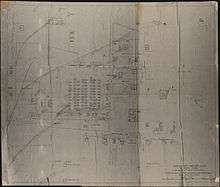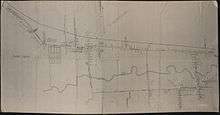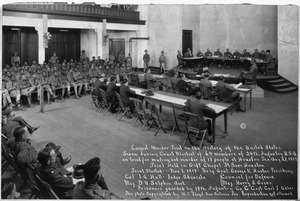Houston riot of 1917
| Houston riot of 1917 | |||
|---|---|---|---|
|
Court Martial of 64 members of the 24th Infantry. Trial started Nov. 1, 1917, Fort Sam Houston | |||
| Location | Houston, Texas | ||
| Parties to the civil conflict | |||
|
| |||
| Lead figures | |||
|
| |||
| Arrests, etc | |||
| |||
The Houston riot of 1917, or Camp Logan riot, was a mutiny by 156 African American soldiers of the Third Battalion of the all-black Twenty-fourth United States Infantry Regiment. It occupied most of one night, and resulted in the deaths of four soldiers and sixteen civilians. The rioting soldiers were tried at three courts-martial. A total of nineteen would be executed, and forty-one were given life sentences.
Preliminary situation

Shortly after the United States declared war on the German Empire in the spring of 1917, the War Department rushed to construct two new military installations in Harris County, Texas — Camp Logan and Ellington Field.[1] On July 27, 1917, the Army ordered the Third Battalion of the Twenty-fourth United States Infantry Regiment to Houston to guard the Camp Logan construction site. The regiment traveled to Houston by train from their camp at Columbus, New Mexico, accompanied by seven white commissioned officers.
Precipitating causes
Almost from the arrival of the Twenty-fourth Infantry in Houston, the presence of black soldiers in the segregated Texas city caused conflict.[2]:10 The Jim Crow laws had not been enforced when the Twenty-fourth was deployed in Columbus, New Mexico,[3] but in Houston the soldiers encountered segregated street cars and white workers at Camp Logan who demanded separate drinking water tanks. Soldiers from the Twenty-fourth were involved in a number of "clashes" with city police, several of which resulted in the soldiers receiving minor injuries.[2]:10
Around noon August 23, 1917, Lee Sparks and Rufus Daniels, two Houston police officers, broke up a craps game on a street corner in Houston's predominantly-black San Felipe district by firing warning shots.[2]:12 Sparks, searching for the fleeing suspects, entered the house of local resident Sara Travers.[4] He did not find the suspect but after exchanging words with Travers he struck her and dragged her outside in her nightgown.[5] As Sparks and Daniels called in the arrest from an area patrol box, they were approached by Private Alonzo Edwards. Edwards offered to take custody of Travers, but was pistol-whipped repeatedly by Sparks and then arrested.[5] Later that afternoon, Corporal Charles Baltimore approached Sparks and Daniels in the same neighborhood to inquire about the status of Edwards. Sparks struck Baltimore with his pistol and fired three shots at him as he fled into a nearby home. Sparks and Daniels pursued Baltimore, eventually finding him under a bed. They pulled him out, beat him, and placed him under arrest.[2]:10 A rumor reached the camp of the Twenty-fourth that Baltimore had been shot and killed. The soldiers immediately began meeting in small groups to discuss plans to march on Houston and attack the police.[6]:1390 An officer from the Twenty-fourth retrieved an injured but living Baltimore from the police station, which seemed to calm the soldiers for the moment.[2]:126
The riot
The officers of the Twenty-fourth continued to receive reports of impending trouble from the angry soldiers.[7] Major K. S. Snow revoked all passes for the evening and ordered the guard to be increased, but later that evening he stumbled upon a group of men stealing ammunition from one of the supply tents.[2]:39 He ordered the men to assemble without arms and warned them that it was "utterly foolish, foolhardy, for them to think of taking the law into their own hands."[2]:40 One of the men, who had smuggled his rifle into the formation, fired it and cried out that a mob was approaching the camp. At this point, order broke down completely and the soldiers mobbed the supply tents, grabbing rifles and ammunition.[6]:1292
The soldiers began firing indiscriminately into the surrounding buildings. After several minutes of shooting, Sergeant Vida Henry ordered the men in the area - about 150 of them - to fill their canteens, grab extra ammunition, and fall in to march on Houston.[6]:1295 The group marched through neighborhoods on the outskirts of the city, firing at houses with outdoor lights. They fired on a car with two white occupants, but let a second car with black occupants leave unharmed.[2]:1214 They marched nearly two and a half miles, all the way to the San Felipe district, before they encountered any police officers. Due to the disorganization of the police department, officers had only been sent out in small numbers[8]:141 so the first police casualties occurred when a group of six officers stumbled upon the entire column of soldiers. Two policemen (including Rufus Daniels) were killed immediately, and one later died of the wounds he received.[2]:527
The soldiers stopped a car carrying two policemen, who were disarmed and shot. A few blocks later, an open-topped car carrying a man in an olive-drab uniform approached the column. Believing this to be the uniform of a Houston mounted policeman, the soldiers opened fire only to discover later that they had killed Captain Joseph W. Mattes of the Illinois National Guard.[2]:651 The killing of a military officer drove home the seriousness of their actions, and the mutineers began to lose heart.[8]:162 Many soldiers began to desert the group, and Sergeant Henry led the remainder on a march to return to camp. Just outside the San Felipe district, Henry shook hands with the remaining soldiers and informed them that he planned to kill himself after they left.[6]:1322 Henry's body was found in the area the next day.[9]
By the time the shooting had stopped, 17 people were dead (four police officers, nine civilians, and two soldiers).[10] One soldier and a police officer later died from wounds sustained during the riot, and one soldier died from wounds sustained during his capture the next day. All of the wounds received by soldiers the night of the riot were the result of accidental shootings by fellow soldiers.[8]:169
Immediate aftermath
The next morning, Houston was placed under martial law.[11] The remaining soldiers in the Twenty-fourth's camp were disarmed, and a house-to-house search discovered a number of soldiers hiding in the San Felipe district. Soldiers in local jails were turned over to the Army, and the Third Battalion was sent by rail back to New Mexico.[12]
In the ensuing Court Martial, almost two hundred witnesses testified over twenty-two days and the transcripts of the testimony covered more than two thousand pages. Author Robert V. Haynes suggests that General John Wilson Ruckman was “especially anxious for the courts-martial to begin”.[8]:251 Ruckman had preferred the proceedings take place in El Paso, but eventually agreed to allow them to remain in San Antonio. Haynes feels the decision was made to accommodate the witnesses who lived in Houston, plus “the countless spectators” who wanted to follow the proceedings (p. 254).[8] Ruckman “urged” the War Department to select a “prestigious court”.[8]:255 Three brigadier generals were chosen, along with seven full colonels and three lieutenant colonels. Eight members of the court were West Point graduates. The court contained a geographic balance between northerners, southerners and westerners.

The Departmental Judge Advocate General, Colonel George Dunn, reviewed the record of the first court martial (known as “the Nesbit Case.”) and approved the sentences. He forwarded the documents materials to Gen. Ruckman on December 3. Six days later, thirteen of the prisoners (including Corporal Baltimore) were told that they would be hanged for murder, but they were not informed of the time or place.[8]:3 The court recommended clemency for a Private Hudson, but General Ruckman declined to grant it. Many soldiers were wrongly accused because no witnesses were able to distinguish the soldiers during the riot.
The first hanging
The condemned soldiers (one sergeant, four corporals, and eight privates) were transferred to a barracks on December 10. That evening, motor trucks carried new lumber for scaffolds to some bathhouses built for the soldiers at Camp Travis near a swimming pool in the Salado Creek. The designated place of execution was several hundred yards away. Army engineers completed their work by the light of bonfires. The thirteen condemned men were awakened at five in the morning and brought to the gallows. They were hanged simultaneously, at 7.17am, one minute before sunrise. The scaffolds were disassembled and every piece returned to Fort Sam Houston. The New York Times, commenting on the clean-up operations, observed the place of execution and place of burial were “indistinguishable.” Only army officers and County Sheriff John Tobin had been allowed to witness the execution.
Gen. Ruckman told reporters he had personally approved the death sentences and said that forty-one soldiers had been given life sentences and four received sentences of two and a half years or less. He said he was the one who chose the time and place for the executions.[8]:7 Military jurist Frederick Bernays Wiener has observed that Ruckman's approval and execution of the death sentences were “entirely legal” and “in complete conformity” with the 1916 Articles of War.[13]:122
Second and third courts martial
A second court-martial, the "Washington" case, began six days later. Fifteen men of the Lower A Division were tried and five were sentenced to death. On January 2, 1918, Ruckman approved the sentences in a public statement. But a new rule, General Orders 167 (Dec. 29, 1917), prohibited the execution of any death sentence until the Judge Advocate General could review the sentence.[13]:115 (The JAG Boards of Review tasked with reviewing death sentences were created by a subsequent rule, General Orders 7 (Jan. 7, 1918).[13]:115[14]:2–3 Those boards, though they had advisory power only, were the Army's first appellate courts.[14]:3)
While waiting for the JAG review to occur, Ruckman approved a third court-martial, the "Tillman" case, of forty more soldiers. On March 26, 1918, twenty-three of those forty soldiers were found guilty. Eleven of the twenty-three were sentenced to death and the remaining twelve to life in prison. On May 2, Ruckman approved the sentences.
Wilson's clemency and commentary
On August 31, 1918, President Wilson granted clemency to ten soldiers by commuting their death sentences to life in prison.[15] Wilson also issued a rare public statement in order that the basis of his action might be “a matter of record.”[16]
The President’s statement began by recounting the events that led to the deaths of “innocent bystanders” who were “peaceable disposed civilians of the City of Houston.”[15] He noted the investigations that followed were “very searching and thorough.” In each of the three proceedings, the court was “properly constituted” and composed of “officers of experience and sobriety of judgment.” Wilson also noted “extraordinary precautions” were taken to “insure the fairness of the trials” and, in each instance, the rights of the defendants were “surrounded at every point” by the “safeguards” of “a humane administration of the law.” As a result, there were “no legal errors” which had “prejudiced the rights of the accused.”[16]
Wilson stated that he affirmed the death sentences of six soldiers because there was “plain evidence” that they “deliberately” engaged in “shocking brutality.”[16] On the other hand, he commuted the remaining sentences because he believed the “lesson” of the lawless riot had already been “adequately pointed.” He desired the “splendid loyalty” of African American soldiers be recognized and expressed the hope that clemency would inspire them “to further zeal and service to the country.”
Most importantly, from General Ruckman’s standpoint, Wilson (a former law professor) wrote the actions taken by the former Commander of the Southern Department were “legal and justified by the record.” Indeed, the President agreed that “a stern redress” of the rioters’ “wrongs” was the “surest protection of society against their further recurrence.” However, the morality and justice of the trial was doubted from the first.[15] As historian Calvin C. Smith noted in 1991, there was no proof of a "conspiracy," and many of the sentenced were not conclusively identified in the dark and rainy night as having even participated in the riot.[17] Whites who defended Houston from the illegal actions of the rioting blacks were not charged for their actions.[18]
On September 29, 1918, five more soldiers met their deaths at daybreak. One week later, the sixth was marched to the gallows.
Camp Logan today

The area where Camp Logan was located is now called Memorial Park. It is bordered by highways I-10 and I-610.
See also
- History of the African-Americans in Houston
- Turner W Bell - Famous Black lawyer who defended some of the soldiers
References
- ↑ Johnson, Thomas A. (1999), A History of the Houston Police Department, retrieved 2013-03-02
- 1 2 3 4 5 6 7 8 9 10 United States vs. Sergeant William C. Nesbit, et al., 1.
- ↑ "Negro Uprising Been Feared For Days, Says Chief". Houston Chronicle. 24 Aug 1917. p. 5.
- ↑ Christian, Garna L. (1 Jan 2009). "The Houston Mutiny of 1917". Trotter Review. 18 (1): 112.
- 1 2 Greuning, Martha (November 1917). "Houston: An N.A.A.C.P. Investigation". The Crisis. 15 (1). pp. 14–19. ISSN 0011-1422.
- 1 2 3 4 United States vs. Corporal Robert Tillman, et al., 24th Infantry, 2.
- ↑ Record of Trial by General Court Martial of Corporal John Washington, et al., 24th Infantry, 1, p. 22.
- 1 2 3 4 5 6 7 8 Haynes, Robert V. (1976). A Night of Violence: The Houston Riot of 1917. Louisiana State University Press. ISBN 978-0-8071-0172-8.
- ↑ "Vida Henry Inquest". 24 Aug 1917.
- ↑ "17 Killed; 21 Are Injured in Wild Night". Houston Chronicle. 24 Aug 1917. p. 1.
- ↑ "Martial Law Declared". Houston Post. 24 Aug 1917. p. 1.
- ↑ Trotter, Joe William (2001). The African American Experience: From Reconstruction. Boston: Houghton Mifflin Company.
- 1 2 3 Wiener, Frederick Bernays (1989). "The Seamy Side of the World War I Court-Martial Controversy" (PDF). Military Law Review. 123: 109–128. Retrieved 11 December 2015.
- 1 2 Borch, Fred L., III (2011). "'The Largest Murder Trial in the History of the United States': The Houston Riots Court-Martial of 1917" (PDF). The Army Lawyer (February 2011): 1–3.
- 1 2 3 Morris, Lawrence J. (2010). Military Justice: A Guide to the Issues. ABC-CLIO. ISBN 978-0-275-99366-5.
- 1 2 3 "President Saves Rioters; Commutes Sentences of Half a Score of Negro Soldiers Convicted of Murder.". The New York Times. September 5, 1918. p. 10. ISSN 0362-4331. Retrieved 2013-03-02.
- ↑ Smith, C. Calvin (1991). "The Houston Riot of 1917, Revisited" (PDF). Houston Review. 13: 85–95. Retrieved 2013-03-02.
- ↑ Smith, C. Calvin (1991). "The Houston Riot of 1917, Revisited". Griot. 10 (1): 3–12.
Further reading
- Aulbach, Louis F. (2011). "The Tragic Violence Along Buffalo Bayou in 1917". Buffalo Bayou: An Echo of Houston's Wilderness Beginnings. CreateSpace Independent Publishing Platform. ISBN 978-1-4681-0199-7.
- Dewey, Andy (August 23, 2016). "The Texas history that's not in the textbooks". Houston Chronicle.
- Haynes, Robert V. (April 1973). "The Houston Mutiny and Riot of 1917". Southwestern Historical Quarterly. 76 (4): 418–439. JSTOR 30238208.
- Haynes, Robert V. (June 15, 2010). "Houston Riot of 1917". Handbook of Texas (online ed.). Texas State Historical Association.
- McEachin, James (1997). Farewell to the Mockingbirds: A Novel. Rharl Publishing Group. ISBN 978-0-9656661-9-0. (Novelization of the riot.)
- McGhee, Fred. L. (2012). Two Texas Race Riots. Fidelitas Publishing. ISBN 978-0-615-62879-0.
- Smith, C. Calvin (1991). "The Houston Riot of 1917, Revisited" (PDF). The Houston Review. Houston Public Library. 13 (2): 85–95.
- Wisenberg, S.L. (August 23, 2016). "The 1917 Houston riot. And the era of Black Lives Matter". Houston Chronicle.
External links
- "Thirteen Negro Soldiers Hanged for Rioting in Houston, Texas". The Commercial & Financial Chronicle ...: A Weekly Newspaper Representing the Industrial Interests of the United States. Volume 105, Part II. William B. Dana Company. 1918. p. 2337. List of 13 executed
- "Negro Soldiers Must Die". Woodville Republican. Woodville, Mississippi. January 12, 1918. List of five sentenced to be executed
- "Houston Mutiny and Riot Records". The Fred Parks Law Library. Houston College of Law.
- Symposium: The Largest Murder Trial in American History: Exploring the Houston Riot of 1917 and its Impact on Military Justice Today
